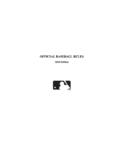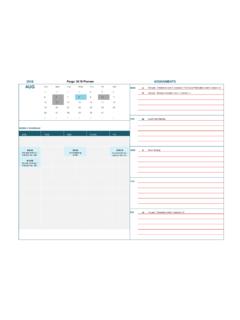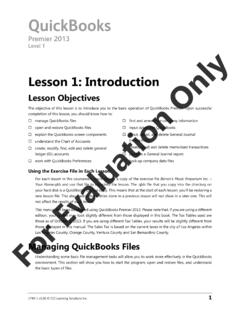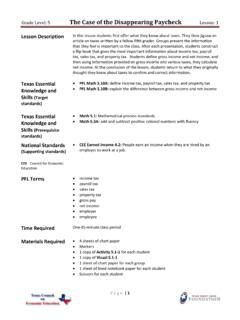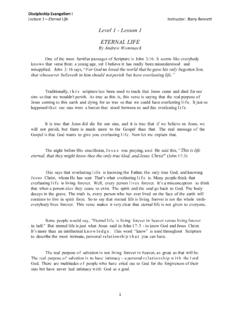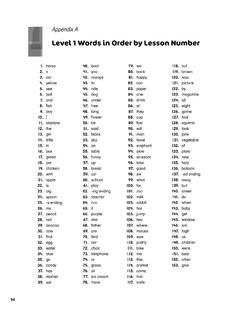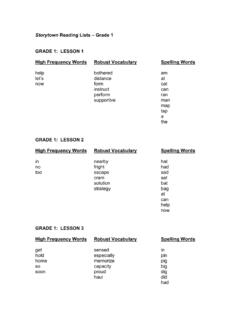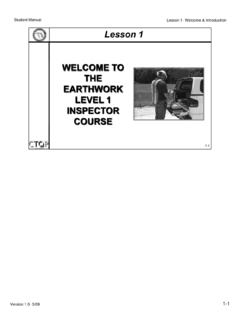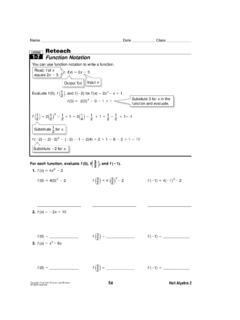Transcription of GEOMETRY - MLB.com
1 GEOMETRYCIRCLING THE BASESGEOMETRYC ircling the BasesHOUSTON ASTROS IN PARTNER WITH THE NBHOFL evel 1 - Page 1 of 10 lesson 1: PRE-VISIT - WHAT S YOUR ANGLE?OBJECTIVE: Students will be able to: Define point, line, line segment, and angle. Classify right, acute, and obtuse angles. Use a protractor to measure and draw REQUIRED: 1 class periodMATERIALS NEEDED: Protractors Pencils Paper Copies of the Identifying Angles worksheet (Included) - 1 for each student Copies of the Baseball Diamond Angles worksheet (Included) 1 for each student A variety of colored pencils 3 sheets of poster board Index cards (2 for each student) Glue sticks or tapeVOCABULARY: Angle - The figure formed by two lines extending from the same point Acute Angle - An angle measuring less than 90 degrees Degree - A unit of measure for angles Line Segment - A part of a straight line included between two points Obtuse Angle - An angle measuring greater than 90 degree and less than 180 degrees Point - A geometric element that has position but no dimensions and is pictured as a small dot Ray - A line that has one endpoint.
2 With the other endpoint extending to infinity Right Angle - An angle measuring exactly 90 degrees Vertex - The point where two line segments or rays meet to form an angleGEOMETRYCIRCLING THE BASESGEOMETRYC ircling the BasesHOUSTON ASTROS IN PARTNER WITH THE NBHOFAPPLICABLE TEKS STATE STANDARDS: lesson 1 , , , , , and Process Standards , , 1 - Page 2 of 10 GEOMETRYCIRCLING THE BASESGEOMETRYC ircling the BasesHOUSTON ASTROS IN PARTNER WITH THE NBHOFL evel 1 - Page 3 of 10 lesson 1: LESSON1| Begin the lesson by asking students to take out a piece of lined paper and fold it in half vertically. Have students label the paper with the heading GEOMETRY Dictionary. Have them label the two columns created by the fold Word and Definition.
3 Students will use this dictionary throughout the unit as a reference, adding more pages as necessary. 2| Explain that GEOMETRY is a branch of mathematics that deals with points, lines, angles, and | Students may start their GEOMETRY Dictionaries right away by recording the definition of | Draw a diagram of a baseball infield on the board or on a sheet of chart paper. 5| Explain that a point is a geometric element that has position but no dimensions and is pictured as a small dot. Use the example of a player standing on a baseball field. Draw a point on the infield diagram drawn in the previous step. Have students add the word point to their GEOMETRY Dictionaries. 6| Next, explain that a line segment is a part of a straight line included between two points.
4 Use the example of one baseball player throwing a ball to another player. Draw a second point on the infield diagram, and then draw a line segment between the two points now on the diagram. Have students add the word line segment to their GEOMETRY | Now, explain that an angle is a figure formed by two lines extending from the same point. Using the infield diagram, show students that an angle on a baseball field is created by the 1st and 3rd base lines (intersecting at home plate). Have students add the word angle to their GEOMETRY Dictionaries. GEOMETRYCIRCLING THE BASESGEOMETRYC ircling the BasesHOUSTON ASTROS IN PARTNER WITH THE NBHOFL evel 1 - Page 4 of 10 lesson 1: lesson - CONTINUED8| Explain the term vertex as the point at which the two line segments of an angle meet.
5 Have students add this word to their GEOMETRY Dictionaries. Using the 1st and 3rd base line angle, show students that the vertex of the angle is home plate. 9| Draw two different angles on the board. Explain that in GEOMETRY , angles are measured in units called degrees. Show students the symbol for degree. 10| Hand out protractors to all students. Show students how to use a protractor to determine the measurement of a given angle. 11| Draw, describe, and define different types of angles: Right angle: An angle measuring exactly 90 degrees Acute angle: An angle measuring less than 90 degrees Obtuse angle: An angle measuring greater than 90 degree and less than 180 degrees12| Have students record all four angle types in their GEOMETRY | Practice identifying angles around the classroom.
6 Encourage students to look around and find examples of obtuse, acute, and right | Introduce the THE BASESGEOMETRYC ircling the BasesHOUSTON ASTROS IN PARTNER WITH THE NBHOFLESSON 1: ACTIVITY1| First, divide students into small groups of 3-4. 2| Provide each group with three Baseball Diamond Angles worksheets (included) and a protractor. Have groups choose three different colored pencils to represent three different types of angles (right, acute, obtuse). 3| Within their small groups, have students work together to create three different types of angles on the three worksheets (one sheet for each angle). For each angle, students should select three baseball positions (catcher, pitcher, first base, second base, third base, shortstop, right field, left field, center field) and place a point at each selected position.
7 4| Students should then connect the three points on their worksheet to form an angle using the crayon or colored pencil of their choice. Finally, they should measure and label the angle. 5| Collect students finished work. Organize the worksheets by angle type, hole punch them, and connect them to form books of right, acute, and obtuse angles. 6| Next, pass out two index cards to each student. Have each student draw a different angle on each of their index cards, but do not measure or label them. 7| When students have finished creating their angles, collect the cards. Mix them up and redistribute them so that each student has two cards drawn by other students. Now have students measure and label each card with the appropriate angle.
8 8| While students are working, bring out 3 sheets of poster board. Label each with the name of a different type of angle (right, acute, obtuse). Hang them up around the 1 - Page 5 of 10 GEOMETRYCIRCLING THE BASESGEOMETRYC ircling the BasesHOUSTON ASTROS IN PARTNER WITH THE NBHOFL evel 1 - Page 6 of 10 lesson 1: ACTIVITY - CONTINUED9| Have students use glue sticks or tape to stick the angles they have labeled onto the appropriate poster : To conclude this lesson and check for understanding, for homework, have students complete the Identifying Angles worksheet (included). Instruct students to use a protractor to find the angle degree and the type of angle. GEOMETRYCIRCLING THE BASESGEOMETRYC ircling the BasesHOUSTON ASTROS IN PARTNER WITH THE NBHOFL evel 1 - Page 7 of 10 lesson 1: IDENTIFYING ANGLESINSTRUCTIONS: Use a protractor to find the measure of each angle represented by these batters stances.
9 Then, identify the type of angle. NAME| DATE|1|2|3|4|GEOMETRYCIRCLING THE BASESGEOMETRYC ircling the BasesHOUSTON ASTROS IN PARTNER WITH THE NBHOFLESSON 1: IDENTIFYING ANGLES1| Angle Degree _____ 1| Type of Angle _____2| Angle Degree _____ 2| Type of Angle _____3| Angle Degree _____ 3| Type of Angle _____4| Angle Degree _____ 4| Type of Angle _____5| Angle Degree _____ 5| Type of Angle _____Level 1 - Page 8 of 105|GEOMETRYCIRCLING THE BASESGEOMETRYC ircling the BasesHOUSTON ASTROS IN PARTNER WITH THE NBHOFLESSON 1: IDENTIFYING ANGLES ANSWER KEY1| Angle Degree _____ 1| Type of Angle _____2| Angle Degree _____ 2| Type of Angle _____3| Angle Degree _____ 3| Type of Angle _____4| Angle Degree _____ 4| Type of Angle _____5| Angle Degree _____ 5| Type of Angle _____70 Acute90 Right60 Acute130 Obtuse130 ObtuseLevel 1 - Page 9 of 10 GEOMETRYCIRCLING THE BASESGEOMETRYC ircling the BasesHOUSTON ASTROS IN PARTNER WITH THE NBHOFLESSON 1: BASEBALL DIAMOND ANGLES1| TEAM NAMES _____ _____ _____ _____ _____ANGLE DEGREE _____ TYPE OF ANGLE _____Level 1 - Page 9 of 10

